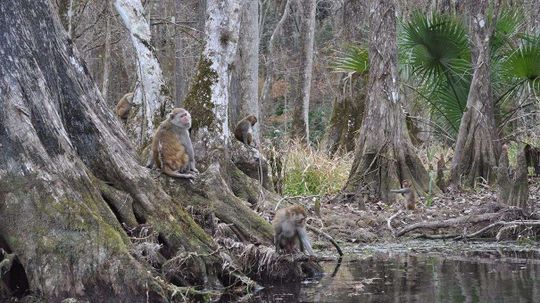As the sun sets over the picturesque landscapes of Florida, an enigmatic phenomenon unfolds beneath its tranquil waters. Contrary to popular belief, this captivating state is not solely renowned for its theme parks and alligators; it also harbors a hidden treasure – a river teeming with monkeys. This unexpected presence of primates in such an unconventional habitat beckons us to delve deeper into their origins and unravel the mysteries that surround them.
An Unconventional Abode for Primates
Intriguingly, nestled amidst the lush greenery and serene waterways lies Silver Springs State Park, home to an astonishing population of rhesus macaques. These charismatic creatures have made themselves at home along the banks of Silver River, creating a spectacle that defies traditional expectations.
While one might assume these monkeys are escapees from nearby zoos or exotic pet owners’ collections gone awry, evidence suggests otherwise. Historical records indicate that these rhesus macaques were intentionally introduced to Florida’s wilds during the 1930s as part of a misguided attempt by humans to enhance local tourism.
This audacious endeavor involved importing several individuals from Asia’s distant shores and releasing them into their newfound Floridian abode. Little did they know then that this seemingly harmless act would set in motion an ecological puzzle spanning generations.
A Controversial Conundrum
The presence of non-native species within delicate ecosystems often sparks heated debates among scientists and conservationists alike. The introduction of rhesus macaques into Florida has been no exception; concerns regarding potential impacts on native flora and fauna have fueled ongoing discussions surrounding their management.
Studies conducted over recent years have revealed that these monkeys have successfully adapted to their new environment, thriving in the subtropical climate and abundant food sources. Their presence has not only altered the dynamics of Silver Springs State Park but also raised questions about potential disease transmission and conflicts with human activities.
Furthermore, as rhesus macaques are known carriers of herpes B virus, a pathogen potentially fatal to humans, concerns regarding public safety have emerged. While no documented cases of transmission from these primates to humans exist within Florida’s borders, the possibility remains a subject of scientific inquiry and vigilance.
A Future Shrouded in Uncertainty
The fate of this peculiar primate population hangs precariously in the balance as scientists grapple with finding an optimal solution. The challenge lies not only in mitigating potential ecological disruptions but also ensuring public safety without compromising animal welfare.
Efforts are underway to monitor and manage this unique monkey community through non-invasive techniques such as contraception programs and behavioral studies. By understanding their behavior patterns and social structures better, researchers hope to develop strategies that strike a delicate equilibrium between conservation needs and human interests.
Conclusion
In conclusion, Florida’s river full of monkeys stands as a testament to humanity’s capacity for unintentional environmental consequences. This captivating phenomenon challenges our preconceived notions about where certain species belong while highlighting the complexities surrounding invasive species management.
As we navigate this intricate web woven by man-made introductions into natural ecosystems, it is imperative that we approach such situations with caution and scientific rigor. Only then can we hope to unravel nature’s enigmas while preserving its delicate balance for generations yet unborn.



